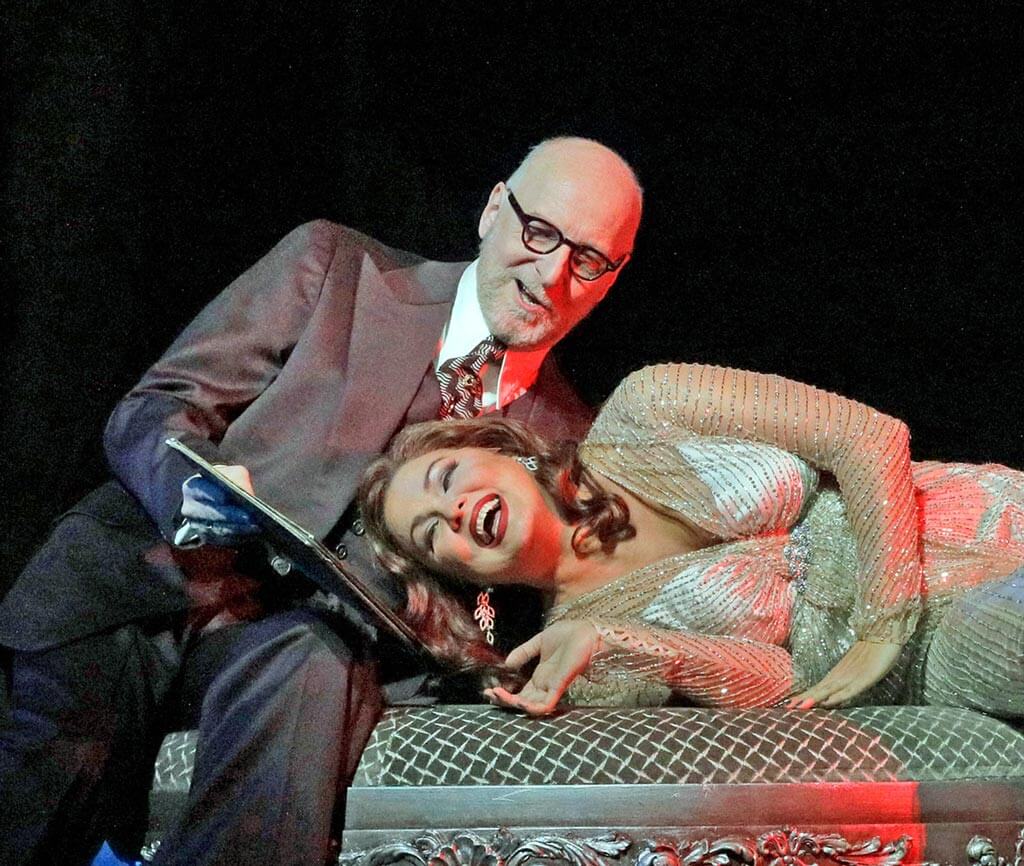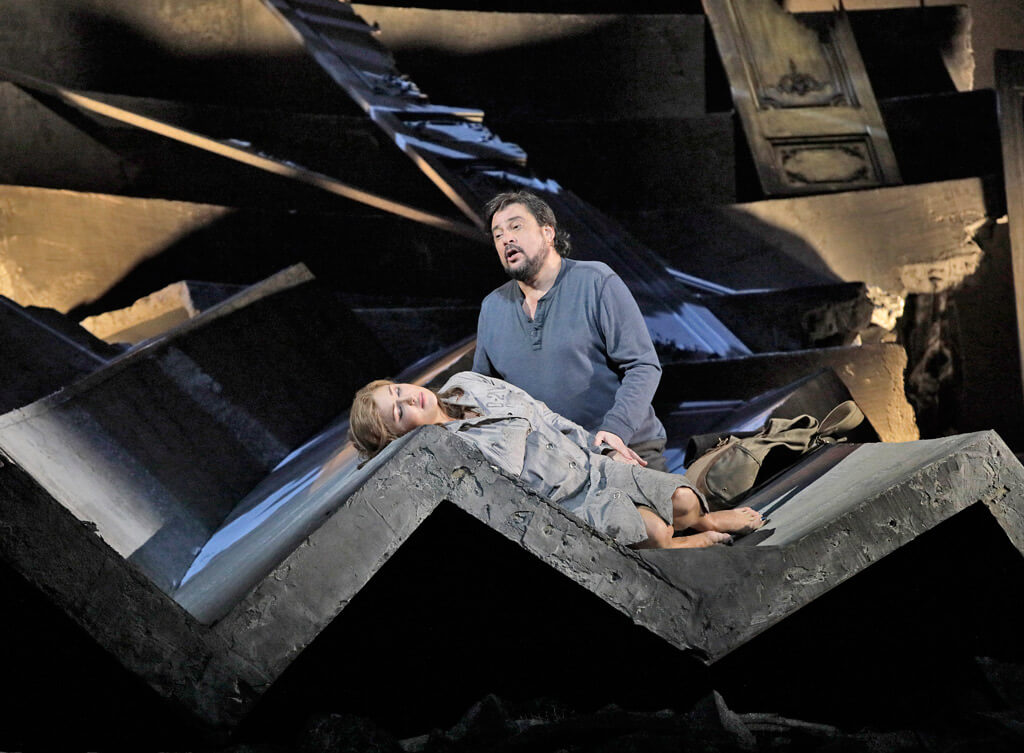
Puccini’s Manon Lescaut at The Metropolitan Opera. Runs through December 10.
NEW YORK CITY — What a disappointment. I travel all the way to New York to see a widely condemned updating of Puccini’s Manon Lescaut, complete with a jumble of sets pointlessly evoking Nazi-occupied France — and I kind of like it.
If this does not assuage my worries about the Metropolitan Opera, it does simplify a recommendation of the live broadcast of Dec. 3, which opens the Saturday afternoon Met season on CBC Radio 2, as a performance probably worth hearing.
This tragedy of 1893, based on the same 1731 novella by Abbé Prévost that inspired the Jules Massenet opera titled simply Manon, was Puccini’s breakout masterpiece. In my view, it is no less engrossing and beautiful than the hits you have heard and seen a hundred times.
Manon Lescaut enjoys an interesting place also in the history of music criticism, owing to the presence at the London premiere of George Bernard Shaw. “Puccini seems to me more like the heir to Verdi than any of his rivals,” he wrote. Good call.
All the same, the work has all but fallen out of the repertoire in Canada. Only the enterprising Pacific Opera Victoria, if my research holds up, has produced it in the 21st-century, and this was a decade ago. Possibly the modern doctrine is to stick to the Puccini big three — La Bohème, Madama Butterfly, and Tosca — if you want a quick hit that is easy to cast.

The Canadian Opera Company last staged Manon Lescaut in 1997, at the Hummingbird Centre. Notices from the time suggest a less than glorious opening night. The Opéra de Montréal put it on the following year, during the reign of Bernard Uzan, with the well-remembered soprano Diana Soviero (his wife) in the title role. My commendatory review included a comment about “a big-voiced tenor from the Atelier program” in the substantial supporting role of Edmondo. This was Marc Hervieux, who went on to become the Andrea Bocelli of Quebec.
But back to the Met. Heading the cast is Anna Netrebko, an ampler soprano in all senses than she once was. This Russian bombshell in the performance I attended made a tragic figure of the title character, who forgoes true love for a life of luxury. Tenor Marcelo Álvarez, as her relentless suitor and would-be saviour Des Grieux, was in every way her equal as actor and vocalist.
The Act 2 duet that finds them together in the home of Geronte, the villainous tax official (and in this production, Vichy collaborator) who has taken on Manon as his mistress, was scalp-tingling stuff. Arias also went well, even if conductor Marco Armiliato tolerated more expressive stretching than I regard as ideal and wielded a heavy baton in the Intermezzo.
Of course, no matter how hard you stare at your radio you do not get a sense of the visuals as conceived by director Sir Richard Eyre and constructed by set designer Rob Howell. These transport the action from the 18th century to the Second World War. “Amiens, France, 1941” reads the projection on the curtain before Act 1 begins.
Surely this should be my cue to launch another philippic against the cult of updating. But it is possible (and in our age, arguably necessary) to adopt a philosophical attitude to such productions, which are now not only in the ascendant but in the majority. Perhaps we should be thankful for what this show gets right. Manon Lescaut, in fact, begins in Amiens and indeed is set in France.
If the lamplighter is turned into a street-sweeper, this is no conceptual hardship. As for the occupation motif, opera fans have certainly had their fill over the last two decades of gratuitous wartime references. But in this instance, the presence of Germans at least creates a feeling of totalitarian restriction that bears some comparison with the politics of the ancient régime.
Geronte (the wonderfully focused British bass Brindley Sherratt) is in a power suit. Fine. He looks like a dirty old man, which is what he is. And the French uniform of Lescaut (the similarly impressive baritone Christopher Maltman) is reasonably concordant with an unscrupulous character who in essence pimps his own sister.
The description of the Holt production posted on the Met website alleges the influence of film noir. In fact, the sets and costumes are colourful, particularly in Act 3, where Manon adopts a Lana Turner look and writhes obligingly in front of an audience including, rather preposterously, a Roman Catholic cardinal. Still, Netrebko in glamour mode is not the stuff of outrage.
The final Act, perhaps inevitably, is a heavily bombed version of the earlier sets. We are to understand that Manon expires not in a “landa sterminata” (vast wasteland) on the outskirts of New Orleans but in war-torn Europe. Whether you buy this or not, it is a substitution of one improbability for another. It has often been noted that Puccini and his librettists were poorly informed on the geography of the American south (before or after the Louisiana Purchase).
And whatever its idiosyncrasies, this Manon Lescaut constitutes a great improvement over the depressing (though finely cast) Tristan und Isolde with which the Met opened the season. This bummer masterminded by Mariusz Treliński (direction) and Boris Kudlička (sets) lifts the archetypal lovers from Wagner’s timeless British Isles and deposits them in a grim 20th-century warship.
The larger question, a few days before the Met premiere of a Salome moved out of antiquity to “a non-specific contemporary setting” (as well, it should be noted, as a lavish Nabucco set in Biblical times) is where the Met is headed under general manager Peter Gelb. The great house has been trying to firm up its modernist street cred, with predictable results at the box office. Even on a Friday evening and with Netrebko as an attraction — especially to the Russians who now constitute a regular and well-dressed minority of the Met audience — the performance of Nov. 18 was far from sold out.
What influence will Yannick Nézet-Séguin, who succeeds James Levine as music director in 2020, have on repertoire and production style? His international success, on the podium and behind the scenes, is based on his mastery of the art of subtle persuasion. This season at the Met YNS conducts a watchable production of Wagner’s The Flying Dutchman from 1989. The radio broadcast is on April 29. Go to www.metopera.org or www.cbcmusic.ca
#LUDWIGVAN
Want more updates on Toronto-centric classical music news and review before anyone else finds out? Follow us on Facebook or Twitter for all the latest.
- SCRUTINY | Moussa Concerto Sounds Strong In Toronto Symphony Orchestra Premiere, Paired With Playful Don Quixote - April 4, 2024
- SCRUTINY | Esprit Orchestra At Koerner Hall: Ligeti 2, Richter No Score - April 1, 2024
- SCRUTINY | Sibelius & New Cello Concerto By Detlev Glanert Offers A Mixed Bag From The TSO - March 28, 2024



